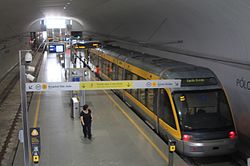Universidade Portucalense Infante D. Henrique
1986 establishments in PortugalEducational institutions established in 1986Private universities and colleges in PortugalSchools in Porto

Portucalense Infante D. Henrique University (UPT) (Portuguese: Universidade Portucalense Infante D. Henrique (UPT)) is a Portuguese private university established as a cooperative on the basis of the Decree No 122/86 of 28 June 1986.
Excerpt from the Wikipedia article Universidade Portucalense Infante D. Henrique (License: CC BY-SA 3.0, Authors, Images).Universidade Portucalense Infante D. Henrique
Rua Doutor António Bernardino de Almeida, Porto Paranhos
Geographical coordinates (GPS) Address Phone number Website External links Nearby Places Show on map
Geographical coordinates (GPS)
| Latitude | Longitude |
|---|---|
| N 41.18 ° | E -8.6069444444444 ° |
Address
Universidade Portucalense Infante Dom Henrique
Rua Doutor António Bernardino de Almeida 541
4200-072 Porto, Paranhos
Portugal
Open on Google Maps








